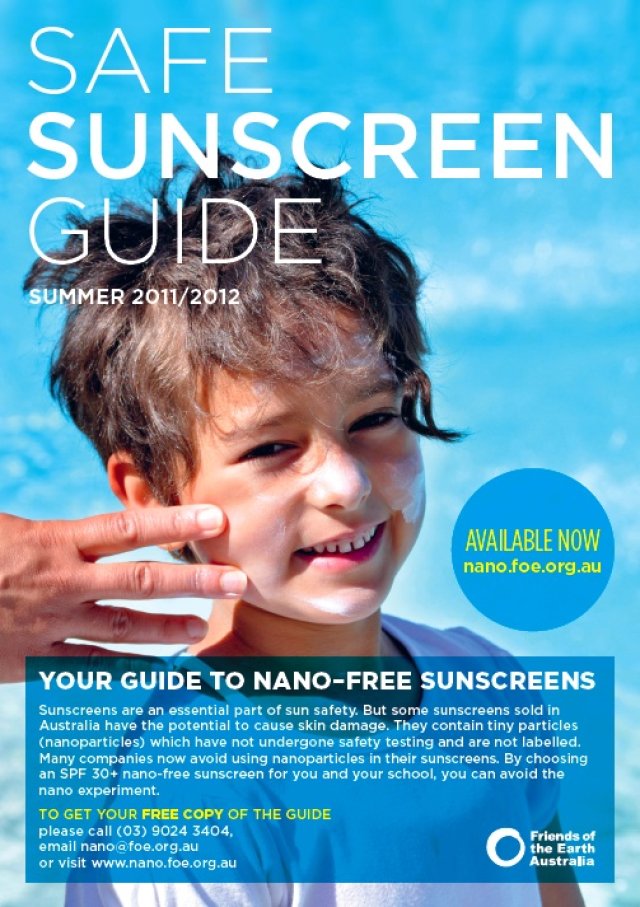
At present, there are no long-term health studies into the nano-ingredients used in many sunscreens. As with all emerging technologies, scientists simply haven’t had enough time to perform these experiments.
When recently confronted with the growing levels of public concern about untested nano-sunscreens, the Australian government continued to sit on its hands.
Due to large gaps in government regulation, companies are still not required to identify nanoparticle zinc and titanium oxide ingredients on product labels, or to conduct nano-specific safety tests on these ingredients. This is despite the growing body of evidence suggesting that rather than protecting us, nano-sunscreens might be causing more damage.
When you reduce the size of chemicals down to the nano-scale, they start to behave differently. Companies use the transparent properties of nanoparticles in sunscreen for aesthetic reasons. However, the key new concerns about nano-sized ingredients in sunscreens is that they are very small and very good at producing dangerous free radicals.
At the nano-scale (1 to 100 nanometres — a namometre is equal to one-billionth of a metre), nanoparticles have the potential to travel around our bodies, in and out of cells, tissues and organs.
There is plenty of evidence showing nanoparticles are very efficient at producing free radicals. So, once a nanoparticle moves inside a cell, resulting free radicals are able to damage proteins and mutate DNA, increasing the risk of cancer.
Widespread concern
In 2009, the NSW government recommended the federal government adopt mandatory labelling of nano-ingredients in sunscreens and cosmetics.
Since then, a growing number of groups — including the Cancer Council, the Australian Education Union, the Australian Consumers Association (Choice) and the cosmetics and sunscreen industry body ACCORD — have called for labelling of nanoparticles in sunscreens for informed choice and public safety.
Recent polling of almost 1300 people, commissioned by Friends of the Earth and carried out by The Australia Institute, found that 85% want nano-ingredients in sunscreens to be labelled. Further, 92% of people surveyed want nano-ingredients to face safety testing before use in sunscreens.
These results show a clear community expectation that new technologies will undergo testing before use and that consumers will have a choice to buy into them or not. However, the national regulator responsible for sunscreens, the Therapeutic Goods Administration (TGA), has so far rejected these calls.
In response to the media around the recent release of Friends of the Earth’s new Safe Sunscreen Guide, the TGA said: “The potential for nanoparticles in sunscreens to cause adverse effects depends primarily upon the ability of the nanoparticles to reach viable skin cells, and to date the current weight of evidence suggests that nanoparticles don’t reach living skin cells, rather they remain on the surface of the skin.”

The TGA position — that nanoparticles can’t hurt us from the outer layers of dead skin — might seem reasonable to many people at first glance. However, a deeper investigation into the science demonstrates that nanoparticles can penetrate the skin.
Recent Australian research showed nano-zinc oxide from sunscreens could be found in the blood and urine of human volunteers. And skin experts have suggested that very young children (whose skin is comparatively thin), people with skin conditions (such as eczema) and people who use sunscreen daily may be at greater risk of nano-exposure.
The federal government’s strong desire to build the fledgling nanotechnology industry appears to have trumped widespread community concerns here in Australia.
In the October 5 Australian, federal science and research minister Kim Carr said: “When we confront new technologies that may have ethical or safety concerns, it is natural that we are cautious. And we have elaborate regulatory systems to exercise that caution.”
But Carr said to admit to risks posed by any nanotechnology would be “to fall victim to scare campaigns”, and suggested Australians “turn their backs on those who would encourage us to stay in the caves of mediocrity”.
Why take the risk?
But many groups believe there is enough evidence to exercise the caution Carr referred to and do not believe that we need to conduct a nano-sunscreen experiment on unknowing Australian consumers.
Friends of the Earth produces the Safe Sunscreen Guide each year to give people a choice to avoid nano-sunscreens.
This year’s survey, of more than 140 sunscreen brands, again confirmed many big brand sunscreens (such as L’Oreal, Garnier and Ambre Solaire) continue to use nano-ingredients. Fortunately, there are a growing number of nano-free sunscreen brands on the market. A full list of nano-free sunscreens can be found in the Summer 2011-12 Safe Sunscreen Guide.
The federal government is considering introducing new nanotechnology safety standards and labelling laws. We encourage you to email health minister Nicola Roxon (nicola.roxon.mp@aph.gov.au) and cc Parliamentary Secretary Catherine King (catherine.king.mp@aph.gov.au) and let them know that you support full safety testing and labelling of nano-ingredients in sunscreen.
[Dr. Gregory Crocetti is a nanotechnology spokesperson for Friends of the Earth Australia.]
Comments
Anonymous replied on Permalink
Anonymous replied on Permalink
Anonymous replied on Permalink
Anonymous replied on Permalink
Anonymous replied on Permalink